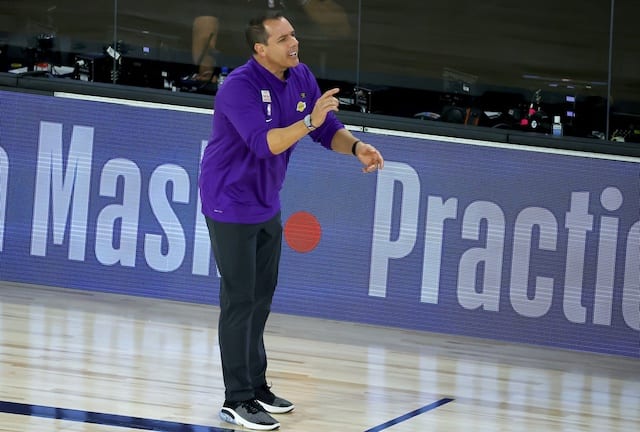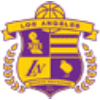For the Los Angeles Lakers and head coach Frank Vogel, the 100-93 loss to the Portland Trail Blazers in their NBA Playoffs return was a sobering moment.
After a string of mediocre performances in the seeding games portion of the NBA restart, Vogel called for patience and insisted L.A. was taking the run-in to the playoffs slowly, finding its rhythm back and exploring roster depth in the absence of Avery Bradley and Rajon Rondo.
The Lakers struggled to find any consistency as a matchup with the red-hot Trail Blazers loomed large. But the message remained clear: there was no need to panic.
And frankly, a loss in Game 1 of a first-round series by no means should indicate panic is necessary. But the way the Lakers performed against the Blazers raises questions over some of the choices Vogel has made since arriving in the Orlando bubble and the conclusions he drew from those painstaking roster experiments he preached.
It quickly became clear a few players needed more time to find their pre-hiatus form during the NBA restart. As luck would have it, among them were Kentavious Caldwell-Pope and Danny Green, those who were meant to share some of Bradley’s responsibilities after the 29-year-old guard opted out.
The Lakers lost three out of the five seeding games they began with Caldwell-Pope and Green in the starting lineup. In every one of them, L.A. started slow and struggled with making shots.
Caldwell-Pope finished the seeding part of the NBA restart shooting 41.5% from the field, including 27.8% from deep, owned a dreadful 90.9 offensive rating (among league-wide lowest) and the second-worst net rating on the team.
Meanwhile, Green had the second-worst defensive rating, fourth-worst net rating, and shot a nightmare 25% from three.
The stats seemed ominous with the first-round series fast approaching and one would imagine Vogel’s experiments would have encouraged him to be more courageous with his playoff rotation.
But as Game 1 rolled around, changes never came and the rest is history. Caldwell-Pope and Green took the first shift guarding the dynamic backcourt of Damian Lillard and CJ McCollum. And that, unsurprisingly, coincided with the Lakers starting the game cold again and shooting miserably against one of the bubble’s worst defenses.
L.A. found themselves 16 down late in the first quarter, having posed virtually no danger from deep despite creating numerous open looks. The nightmares were back and vivid. The Lakers again looked like the bubble’s worst offense, not the West’s top seed.
Caldwell-Pope did at least have some success in keeping Lillard and McCollum at bay. He only allowed the bubble MVP to score four points in nearly four minutes he defended him. McCollum missed his sole shot attempt when covered by the Lakers guard.
But Caldwell-Pope was horrendous offensively, finishing the game with one point and a -18 in 29 minutes.
Green let Lillard score five points in one minute and allowed McCollum’s nine in nearly four minutes. The Lakers veteran ended -20, chipping in 10 points while shooting 33% from the field but making just two of his eight attempts behind the arc.
Nevertheless, Vogel was undeterred and kept his veterans in the game as if to prove everyone else wrong. The two tercets featuring Caldwell-Pope and/or Green alongside LeBron James and Anthony Davis spent the most time in play, racking up 21 minutes each.
The same three-player lineups recorded net ratings of -25.2 and -18.8 accordingly in over 80 minutes spread across five seeding games. Their offensive effort was particularly disappointing.
So it came as no surprise that L.A. shot 25% from the field and 9% from deep when the starting unit was on the floor, allowing Portland to outscore them by nine points. In fact, no other starting lineup fielded in more than one game has fared poorer in the three weeks of the NBA restart.
Considering his openness to potentially run rotations as deep as 10 players, Vogel’s insistence on handing Caldwell-Pope and Green big minutes seems baffling. But only as much as deploying Dion Waiters for no longer than 73 seconds against Portland.
The Lakers’ head coach seemed beyond happy with the explosive guard’s form in Orlando and claimed his skillset provides a much-needed variety to their offensive repertoire.
And data backs it up. Waiters was averaging 11.9 points in the bubble and ranked top five in both the team’s offensive and defensive ratings. When part of the second unit alongside Kuzma and Alex Caruso, the Lakers were much sharper on both ends of the court with the lineup boasting the second-best net rating (40.1) of any other three-man combinations. Only a James-Caruso-Dwight Howard trio fared better.
Waiters, with his swag, toughness and bounce off the dribble, was exactly what the Lakers needed against Portland when pick-and-rolls from James and Davis became their only functioning scoring option.
However, Vogel did not entertain the idea, instead hoping Kuzma, Caruso and Markieff Morris would have provided the Lakers All-Stars with enough support off the bench.
And despite their fair contribution, that particularly hurt L.A. in the fourth quarter. The Lakers went six up quickly, taking their largest lead of the game when the Kuzma-Caruso-Morris trio accompanied James and Howard in the first four minutes of the final period.
In fact, this unit outscored Portland by eight in the six minutes it spent on the court, ranking ninth out of the 473 other lineups that have featured in the playoffs this year.
But when Vogel turned back to Green and Caldwell-Pope, the advantage quickly evaporated. James and Davis each missing a pair of crucial free throws obviously did not help.
Questions were piling up as Lillard and McCollum were making it clear they would upset the Lakers in their first playoff game since 2013.
Why did Vogel’s experiment not involve Caldwell-Pope or Green coming off the bench at all since the seeding games practically did not matter?
What does JaVale McGee have to do to lose his spot in the starting lineup after his input took perhaps the biggest hit of all, resulting in the worst offensive and net ratings among Lakers players in Orlando?
And what happened to rookie Talen Horton-Tucker, who brought a spark nearly every time he was given a chance in the bubble, prompting Vogel himself to say the 19-year-old might crack his rotation?
Or simply, why do players who are way off form play key roles against the toughest eight seed in NBA history?
Not everything looked grim for Vogel on Tuesday night. L.A. held the hottest offense in the league to just 100 points. Morris and Caruso kept repaying the coach’s trust and put in solid stints off the bench. And Kuzma seems like he might be becoming the third star the Lakers so desperately needed.
James and Davis have obviously more to offer themselves, despite the former’s historic night which partly was a byproduct of the Lakers’ impotence.
No adjustment would have guaranteed the Lakers a win over Portland. But that Game 1 was winnable and some of the available options — which were a direct result of Vogel’s meticulous experimentations but he decided not to use them — could have tipped the scale in his team’s favor.
“If you’re afraid to fail, then you’re probably going to fail,” the late Kobe Bryant once famously said. Vogel might be trying to instill the late Lakers legend’s Mamba Mentality in his team with tribute videos all he wants, but to win like Bryant he has to be bold when it comes to crucial team selection.
In both the 2013 and 2014 Eastern Conference Finals between the Indiana Pacers and the LeBron James-led Miami Heat, Vogel did not change the starting lineup once and often kept his starters in the game for around 40 minutes or more.
He has to do better and be more flexible than that in Orlando.
The good news is, Vogel seems to have alternatives at hand that could offer an easy fix to some of his Laker team’s troubles. He just needs, and wants to, use them before it is too late.
Have you subscribed to our YouTube channel? It’s the best way to watch player interviews, exclusive coverage from events, participate in live shows, and more!





